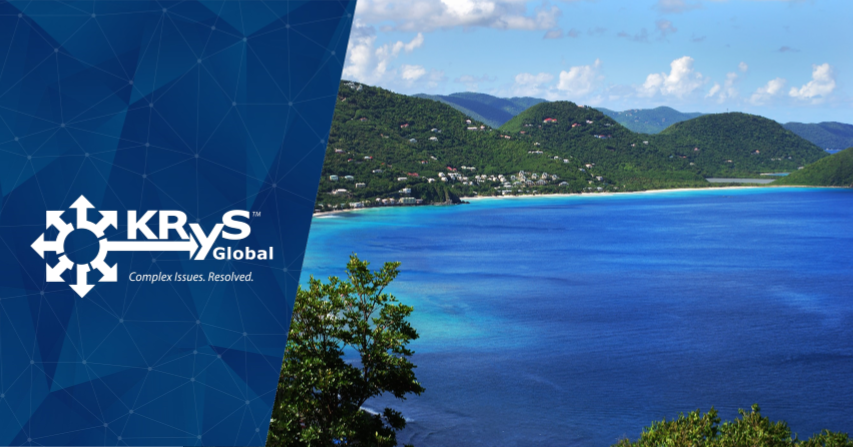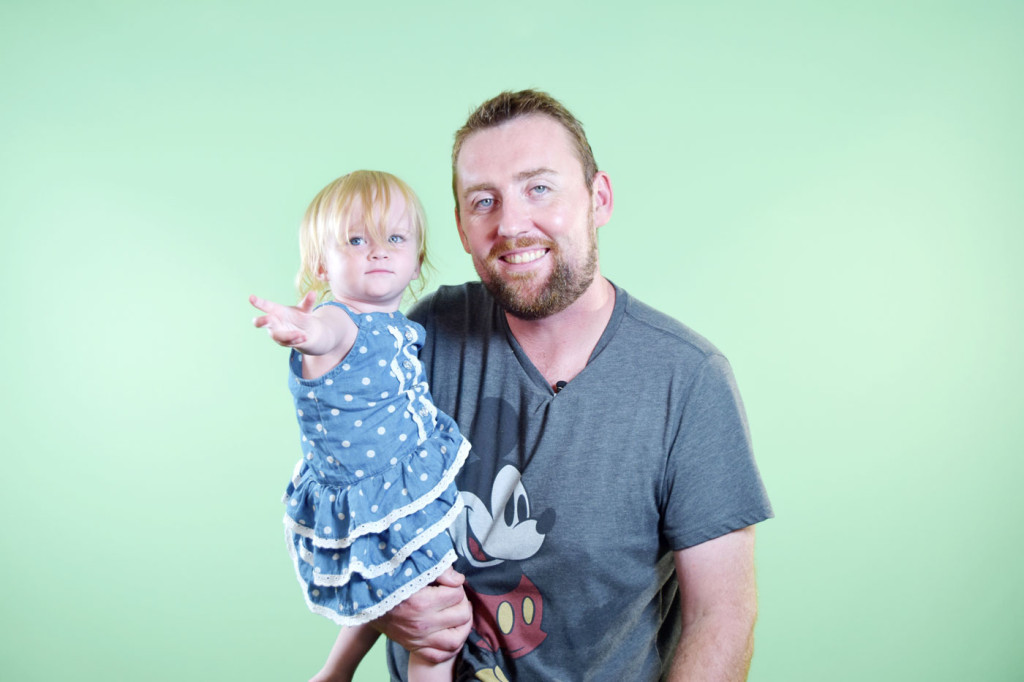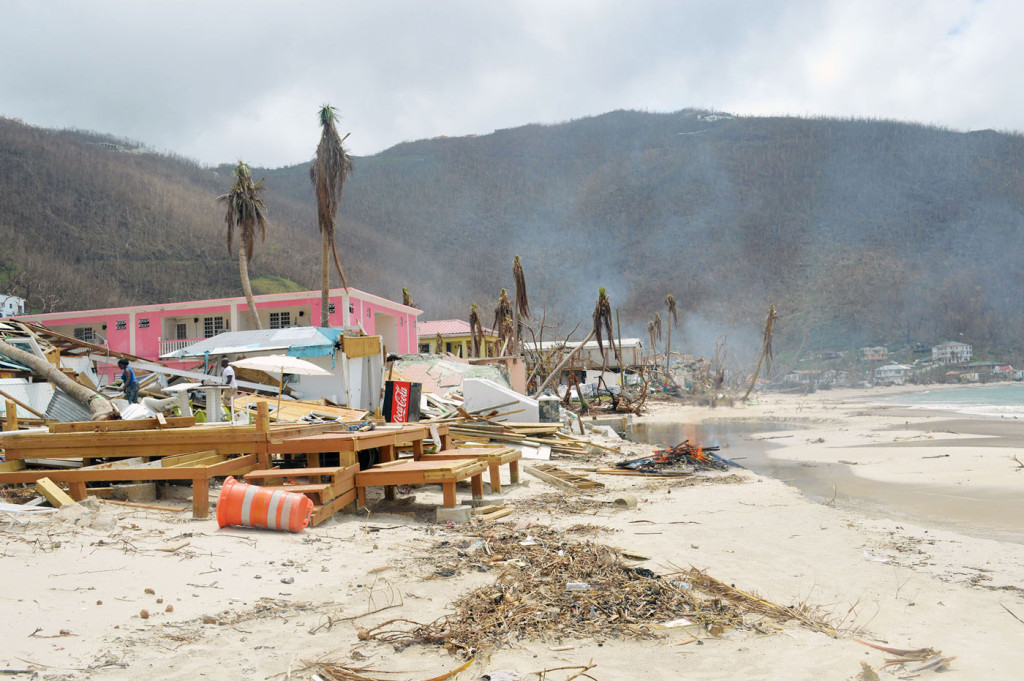Managing Director's Partner Shares BVI Survivor Story

Originally posted on the Caymanian Compass
When Kyrie Caulfield drives on Grand Cayman during rainy days, his pulse quickens, his stomach ties into knots, and his knuckles whiten from gripping the steering wheel too hard.
That reaction may seem odd coming from a longtime dive instructor. But after nearly losing his family and his own life when Hurricane Irma struck the British Virgin Islands last month, he cannot help but become nervous by the recent storms, however minor they may be.
Mr. Caulfield is one of more than 100 displaced BVI residents who came here following the Category 5 storm, one of the fiercest ever recorded in the Caribbean. He moved with his 4-year- and 18-month-old daughters and his pregnant wife, Charlotte Caulfield, the managing director of KRyS Global’s BVI branch, who is now working out of the company’s Cayman offices.
They almost did not make it here after Irma’s 185-mph winds tore off their roof and collapsed the walls around them on Sept. 6 – days after they bought their home.
Before Irma, the BVI’s worst storm in more than a decade had been Tropical Storm Otto in 2010, when associated mudslides and flooding caused just over $10 million in damage.
False sense of security
Having lived through Otto and several other storms that either narrowly missed or were downgraded before hitting the territory, some residents there think they may have been lulled into somewhat of a false sense of security.
Even at the beginning of Sept. 6, when Irma did not hit mid-morning as forecast, Mr. Caulfield said he thought the hurricane might pass over without any serious incidents.
As windspeed picked up around 11 a.m., the Caulfields and another family peered through the hurricane shutters on their home.

“Frankly, it was fascinating. I was watching trees roll sideway across the property … We were almost playing a game of chicken. We’d drop the blinds when stuff started blowing towards us,” said Mr. Caulfield. “Everything was great. It was getting stronger and stronger, but we thought we were OK.”
‘It was just gone’
But around noon, he felt a gust of wind coming from underneath the door leading into a bedroom on the windward side of his house, located facing north on the hills of Cane Garden Bay, Tortola.
“I opened the door to my child’s bedroom, and the room was gone,” he said. “There was no wall, no roof, no windows – it was just gone.”
That is when the group of people knew they were in serious trouble. Trying to stay calm, Mr. Caulfield moved a dresser in front of the bedroom door, which by then was the only thing between his family and the Category 5 storm.
But bracing the door turned out to be the least of his problems. Moments later, the roof on the house “rolled up like a tin can and just blew off into outer space,” he said.
The home’s inhabitants scrambled to the kitchen, the only room where the roof was still intact.
Mr. Caulfield moved the refrigerator in the open entryway between the kitchen and what had been the living room. Irma had other plans for the fridge, however, launching the household appliance 30 feet in the air.
“When the fridge blew out, the kitchen roof also flew up,” said Mr. Caulfield. “My wife picked up our 17-month-old baby, and pushed her into the kitchen cupboard with the intention that we were all going to die, and maybe someone would come along and find the child.”
Swirling debris made an escape out the entryway impossible, so the husband of the other family broke out the wooden slats of a small window at the back of the kitchen.
One by one, each person squeezed through the narrow opening, wondering if the next moment would be their last. When Mr. Caulfield and his infant daughter made it out, the group ran to the alcove of the house but knew they could not stay there long.

Searching for shelter
Down a steep eight-foot hill, a concrete garage looked like the most promising place to flee. Somehow, they all made it to the garage in the midst of the hurricane, and took shelter in a car parked inside.
With no door on the garage, Mr. Caulfield used nearby wood panels to reinforce the car’s windows, hoping they could wait out the remainder of the storm there.
“We started singing ‘Wheels on the Bus’ with the kids,” he said.
Unfortunately, their hopes were dashed when the wind started lifting up the vehicle. Again, Mr. Caulfield had to venture out into the storm to look for another shelter.
This time, he found a house about 150 feet away, owned by people who were off island. Although most of the house was destroyed, at the bottom he found “what I’d describe almost as a prison cell,” he said. There, he found the house’s caretaker, Tyrone.
“[Tyrone’s] saying, ‘You need to go upstairs,’” said Mr. Caulfield. “He’s not trying to get rid of me, he thinks the upstairs is better than the cupboard. Because he had spent the last hour facing the wind, holding the cupboard door closed with just normal wooden slats, thinking he was going to die.”
By then, the eye of Irma was over the island, allowing the families to run from the garage to the small place inhabited by Tyrone, who let them in. The adults spent the next 30 minutes making runs to the house for supplies, passports, money, and their dogs.
From the small “cupboard,” the families and Tyrone waited out the second half of the storm in relative safely – some of the children even fell asleep – though Mr. Caulfield said it was nerve-racking seeing the sea creep higher and higher up the hillside.
“And it got to the point where it was 20 feet below, but normally it’s 80 feet below,” he said. “And we’re all thinking we’re going to drown if this carries on.”
Survival mode
Finally, around 5 p.m., Irma was completely past Tortola, leaving the island totally devastated, and heading west toward Puerto Rico.
“Then survival mode kicks in,” said Mr. Caulfield. “It’s not a situation where your house is burnt down. It’s every single house you can see is destroyed.”
After a restless night, Mr. Caulfield and the other adults spent the entire day gathering supplies and moving them to a friend’s semi-inhabitable home nearby.
Though the mood that day was grim, he took a moment to take footage of him walking through the home that his family had bought just a week before, joking about things like a glass vase that apparently did not move at all during the storm.
“Look, no walls five days later – lovely view!” he exclaimed in the recording, pointing out a scenic sight of the ocean where the front of his house should have been.
Viral video
Digging through the rubble of his home, he found a can of Guinness. After he wiped off the oil, butter, dirt and other debris, he drank the brew in his wrecked house on camera, in what would become a video viewed by millions of people around the world on sites like the Daily Mail and ABC News.
“I found the Guinness, I thought it would be funny … It was warm as toast, but it was the best Guinness of my life,” he said about the moment of levity. “I really thought I was going to die with my children, and no one got a scratch on them. So who gives a monkey about the furnishings?”
Weeks later, Mr. Caulfield reflected bitterly on the fact that dozens of news sites shared the viral video without linking to bvirelieffund.org or any other reputable charity sites, despite his request for them to do so. After Guinness declined his request to donate aid to the territory, he also vowed never to drink that beer again.
But in the immediate aftermath of Irma, his mind was still focused on keeping himself and his family alive.
Two days after Irma, the territory’s capital, Road Town, was starting to teem with residents, government officials, and others beginning relief efforts. People like Robert Briant – a partner of the Conyers Dill and Pearman BVI office, who is now working in Cayman – were able to evacuate at that time to Puerto Rico, which had yet to be devastated in its own right by Hurricane Maria.
However, with mountains separating Cane Garden Bay from most of the rest of Tortola, Mr. Caulfield and his village remained essentially isolated from the world.
“I didn’t see a single person in uniform for a whole week,” he said. “I’m not blaming anyone, but that’s the truth.”
On the eastern end of the island, more than 100 inmates escaped Her Majesty’s Prison, and there were reports of widespread looting in that area. Luckily for Mr. Caulfield and his family, the Cane Garden Bay community remained relatively peaceful.
“It was a real proper community spirit, but at the same time it was on a knife’s edge,” he said. “I’m a firm believer that society is about 12 missed meals from breaking down – and people missed about 10 meals.”
Finally, about two weeks after Irma, Mr. Caulfield and his family flew to Puerto Rico. He left his car for the use of the U.K. marines – “It was like I had given them a tank. They were delighted,” he said – and gave his boat to a friend whose charter yacht business had been destroyed.
Welcome to Cayman
After a few days in San Juan, they came to Cayman, receiving what Mr. Caulfield called a “fabulous” welcome.
“The sister island–hood thing has been totally real,” he said. “My wife went right to work. If we were in the BVI right now, she couldn’t work and her firm would find it very hard to pay the staff.”
Ms. Caulfield, Mr. Briant and dozens of other displaced BVI workers were granted 60-day work permit exemptions to remain in Cayman.
Some have already returned to the BVI, while others with school-age children hope to remain here in Cayman the entire school year.
The Caulfields, for their part, plan to go to the U.K. around Christmastime for the expected birth of their baby, which is due in February. By then, they hope the BVI is repaired to the point where they can return. If not, his family may come back to Cayman if they can, or move to another offshore jurisdiction, he said.
While the Caulfields are grateful for Cayman’s hospitality, they are anxious to begin rebuilding their lives in the BVI, said Mr. Caulfield.
In the meantime, he spends much of his time checking on the status of the territory’s rebuilding efforts. It may take five years or more before the marina he worked at returns to normal, he said.
“If people want to help out the BVI, book a holiday next year.”
